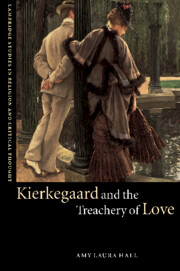Book contents
- Frontmatter
- Contents
- List of abbreviations
- Preface
- Introduction
- 1 The call to confession in Kierkegaard's Works of Love
- 2 Provoking the question: deceiving ourselves in Fear and Trembling
- 3 The poet, the vampire, and the girl in Repetition with Works of Love
- 4 The married man as master thief in Either/Or
- 5 Seclusion and disclosure in Stages on Life's Way
- 6 On the way
- Notes
- Works cited
- Index
3 - The poet, the vampire, and the girl in Repetition with Works of Love
Published online by Cambridge University Press: 22 September 2009
- Frontmatter
- Contents
- List of abbreviations
- Preface
- Introduction
- 1 The call to confession in Kierkegaard's Works of Love
- 2 Provoking the question: deceiving ourselves in Fear and Trembling
- 3 The poet, the vampire, and the girl in Repetition with Works of Love
- 4 The married man as master thief in Either/Or
- 5 Seclusion and disclosure in Stages on Life's Way
- 6 On the way
- Notes
- Works cited
- Index
Summary
When we speak this way, we are speaking of the love that sustains all existence, of God's love. If for one moment, one single moment, it were to be absent, everything would be confused.
(WL, 301)Underneath it all, there must be a misunderstanding.
(R, 136)INTRODUCTION
As the reader moves from de Silentio's question of crossing the river even once to the enigmatic exchange between the cynic and the poet of Repetition, the conundrum of “the girl” becomes explicit. While one might (albeit mistakenly) speak as if Abraham and God were alone on Mount Moriah, the problematic presence of the other is precisely at issue in Repetition. In this story, the beloved on whom the young man focuses his gaze and esteem quickly becomes an encumbrance from which the cynic must rescue him, and the ensuing narrative reveals several facets of love's demise. Kierkegaard's sobering rendition of the love commandment in Works of Love, wherein the beloved is more than merely the beholder's vision of her, exposes that there is indeed an other in the story, imperiled by two characters who would idolize, trick, or banish her. In Works of Love, Kierkegaard distinguishes true love from the poetic perspective, which distorts the other to fit the lover's ideal; from the vampiric gaze, which devours her; and from the sage's inspection, which deems her blameworthy and disposable, and he skillfully depicts each of these three distortions in Repetition.
- Type
- Chapter
- Information
- Kierkegaard and the Treachery of Love , pp. 83 - 107Publisher: Cambridge University PressPrint publication year: 2002

